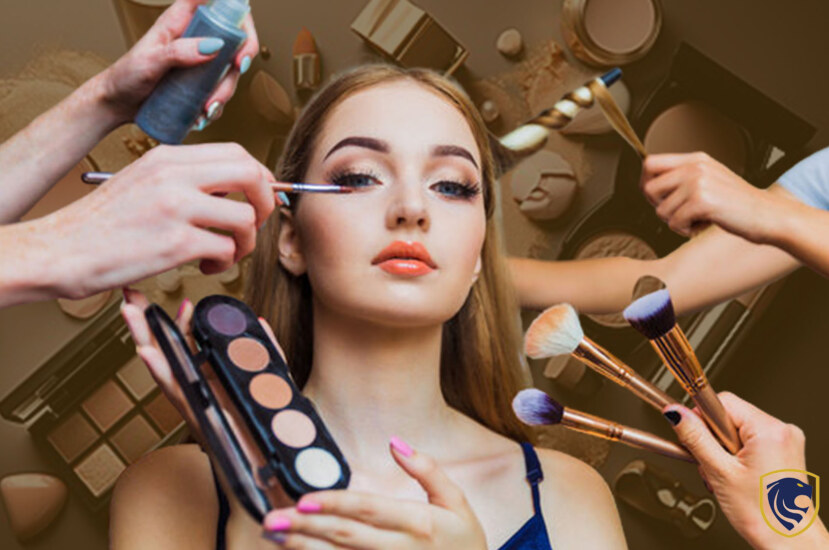Welcome back to the second installment of our cosmetics trip, “Exploring the Makeup Bag: Unveiling the Most Common Ingredients in Cosmetic Products part 2.” In this installment, we’ll dig further into the chemicals that define our beauty regimens, revealing the secrets behind the products we adore. We’re about to reveal the science and creativity that go into producing the beauty staples we use every day, from the alluring colors of Carmine to the protecting capabilities of Phenoxyethanol.
Nylon-12
Nylon-12, a cosmetic magician, plays an important role in cosmetics products. It’s a man-made substance that refines textures and adds an ethereal touch. Nylon-12 produces a silky, smooth texture in powders, making application a breeze. Its finely milled particles diffuse light, reducing flaws for a soft-focus look. Also, its versatility as a powder increases makeup durability by absorbing excess oils. Nylon-12 also improves the bendability and wearability of liquid foundations. Even in stacked applications, its lightweight nature precludes a thick look. While most people handle it well, others may develop moderate discomfort. Individual responses and potential allergies must be considered. Nylon-12’s transformational abilities aren’t limited to texture. It’s also an optical joker, producing a matte finish without seeming flat.

Nylon-12
Exploring our cosmetic bags reveals Nylon-12’s role. It’s the texture changer, the key to that velvety touch that glides on smoothly. It’s the component that keeps makeup looking fresh all day. As we go further into the realm of cosmetics, Nylon-12 emerges as the unsung hero responsible for that immaculate finish, encouraging us to admire its craftsmanship.
Polyethylene
Polyethylene, a versatile material, finds its way into beauty products, giving texture and function. Polyethylene’s small beads easily peel off dead skin cells in exfoliating solutions, exposing a beautiful complexion. Its round design offers a non-abrasive experience, making it suited for all skin types. Polyethylene’s suppleness is especially useful in lip scrubs, providing a mild exfoliation for softer lips. It adds to structure in beauty items such as lipsticks, ensuring that they keep their form. Because of its water resistance, it will not disintegrate or lose efficacy in moist or wet compositions. While typically safe, environmental concerns have prompted a trend towards biodegradable alternatives. Being informed of product contents is essential for making sustainable decisions.

Polyethylene
Polyethylene’s significance emerges when we investigate our cosmetic bags. It’s the exfoliating agent behind a clean canvas, the texturizer that improves lipstick performance. It is the element that blends utility and innovation, guaranteeing that cosmetics products provide a balance of effective performance and environmental stewardship. Polyethylene challenges us to evaluate not just its cosmetic usage but also its environmental effect as we navigate the cosmetics market, urging us to make conscious choices in our beauty regimens.
Lecithin
Lecithin, a versatile emulsifier, is essential in cosmetics. It is derived from plants or soy and assists in the smooth mix of oil and water-based components. Lecithin ensures a soft texture in lip products, allowing lipsticks and glosses to slide on smoothly. It avoids clumping and improves application in eyeliners and mascaras. Because of its skin-conditioning effects, lecithin is an essential ingredient in foundations and concealers. It provides a smooth, velvety sensation while assisting other components in successfully penetrating the skin. Lecithin’s flexibility extends to powdered formulations, where it improves mixability and skin adhesion.

Lecithin
Choosing soy-free goods eliminates any concerns. Lecithin’s presence arises in our investigation of beauty products. It’s the harmonizer, the element that guarantees disparate components combine effortlessly. It acts as a bridge between textures, making makeup application a breeze. Lecithin asks us to recognize its part in developing formulas that not only improve our attractiveness but also make our cosmetic experiences smoother and more pleasurable as we go through our makeup bags.
Kaolin
Kaolin is a common component in cosmetics. It is known for its absorbent characteristics and is derived from clay. Kaolin helps regulate excess oil in powders, resulting in a long-lasting matte finish. Its ability to improve texture makes it a must-have in setting powders, preventing makeup from creasing or fading. Kaolin aids in the smooth application of foundations, resulting in an even canvas. Moreover, its soft nature is ideal for delicate skin, making it a popular ingredient in a variety of formulations. Kaolin lends a silky feel to mineral makeup, making blending easier. Its natural origins are in line with clean cosmetic choices, and it provides a skin-friendly alternative to synthetic components. Kaolin’s moderate exfoliating capabilities make it an excellent ingredient in masks and treatments.

Kaolin
While Kaolin is typically well tolerated, it is critical to avoid breathing Kaolin-containing goods, particularly loose powder. Choosing pressed formulations lowers this danger. In our investigation of cosmetic products, the role of Kaolin emerges. It is the oil absorber and mattifier that guarantees a fresh appearance throughout the day. It’s the element responsible for creating a smooth canvas for makeup application, emphasizing its significance in cosmetics. As we reach for our makeup bags, Kaolin reminds us of its natural ability to improve the effectiveness and durability of our favorite cosmetics.
Phenoxyethanol
Phenoxyethanol, a well-known preservative, is essential in cosmetics. It prevents bacterial development, prolonging the shelf life of cosmetics. Phenoxyethanol inhibits contamination in water-based formulations such as liquid foundations, maintaining the product’s safety. Its antibacterial effects aid mascara as well since they inhibit the formation of hazardous microorganisms. Because of its effectiveness against a wide spectrum of bacteria, phenoxyethanol is a popular option among cosmetic producers. Because of its low toxicity, it is suitable for topical use. Most people handle phenoxyethanol well, although those with sensitive skin may have moderate discomfort. Lower concentrations of products are recommended for maximum safety. While phenoxyethanol is frequently used, some customers prefer items that are preservative-free or organically preserved.

Phenoxyethanol
In our investigation of beauty items, the significance of Phenoxyethanol emerges – it is the keeper of product integrity, the guardian against invisible hazards. It is the element that ensures the quality and safety of our favorite cosmetics. As we go deeper into our makeup bags, Phenoxyethanol reveals the vital function it plays in extending the life and cleanliness of our favorite cosmetics.
Carmine (CI 75470)
Carmine (CI 75470), a compelling pigment, is used in cosmetics. Its vivid reds and pinks in lipsticks, blushes, and eyeshadows are derived from crushed cochineal insects. The natural origin of carmine provides a vividness that is difficult to imitate with synthetic equivalents. Its flexible tint complements a wide range of skin tones, making it a popular option. Those who are allergic to insects or prefer a vegan diet may wish to avoid carmine-containing items. Carmine’s colorant power is its ability to deliver significant coloring even in small amounts. Its color payoff helps that cosmetic items stand out. While it is typically safe, occasional cases of sensitivity may develop. It is best to be cautious and perform patch testing, especially if you have sensitive skin.

Carmine (CI 75470)
Carmine’s brilliance leaps out when we explore makeup goods – it’s the red enhancer, the pigment that gives drama and flare to our cosmetics. It is the element that reminds us of nature’s contribution to the color pallet of beauty. Carmine asks us to understand the function of cosmetics in generating dramatic, strong looks that represent our personality by investigating our makeup bags. It’s a tribute to the various components that combine to make our cosmetic procedures bright and one-of-a-kind.


